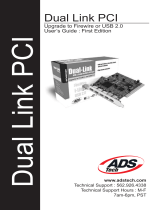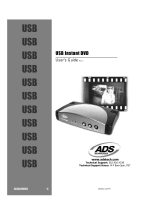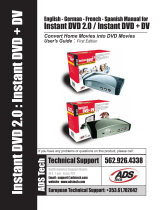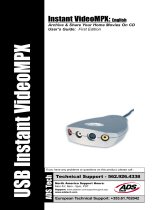Page is loading ...

VIDEOSTUDIO HELP
Table of Contents | Index Back 2
First English edition for Ulead VideoStudio version 7.0, January 2003.
© 1992-2003 Ulead Systems, Inc.
All rights reserved. No part of this publication may be reproduced or transmitted
in any form or by any means, electronic or mechanical, including photocopying,
recording or storing in a retrieval system, or translated into any language in any
form without the express written permission of Ulead Systems,
Inc.
Software license
The software described in this document is furnished under a License
Agreement, which is included with the product. This Agreement specifies the
permitted and prohibited uses of the product.
Licenses and trademarks
ICI Library © 1991–1992 C-Cube Microsystems.
Ulead Systems, Inc., Ulead, the Ulead logo, and Ulead VideoStudio are
trademarks of Ulead Systems, Inc. All other product names and any registered
and unregistered trademarks mentioned in this manual are used for identification
purposes only and remain the exclusive property of their respective owners.
Sample files
Files provided as samples on the program CD can be used for personal
demonstrations, productions and presentations. No rights are granted for
commercial reproduction or redistribution of any sample files.
North & South America International
Ulead Systems Inc. Ulead Systems, Inc.
http://www.ulead.com http://www.ulead.com
E-mail: [email protected] http://www.asiapac.ulead.com
http://www.ulead.com.tw
E-mail: [email protected]
Japan China
Ulead Systems Inc. Ulead Systems, Inc.
http://www.ulead.co.jp http://www.ulead.com.cn
Germany
Ulead Systems GmbH
http://www.ulead.de
E-mail: [email protected]

VIDEOSTUDIO HELP
Table of Contents | Index Back
3
Table of Contents
The big picture ...................................................................... 7
Analog vs. Digital ................................................................................ 7
DVD, VCD, and SVCD......................................................................... 8
How VideoStudio works...................................................................... 9
What’s New ....................................................................... 10
System requirements ............................................................ 12
Hardware checkup before using VideoStudio ............................... 12
DV IEEE 1394 capture card .............................................................. 13
Analog capture card.......................................................................... 15
USB port ............................................................................................ 15
Installing and running VideoStudio ........................................... 16
Configuring VideoStudio ........................................................ 17
DV (IEEE 1394 capture card)............................................................ 17
Analog capture card.......................................................................... 18
USB input device............................................................................... 18
Getting around VideoStudio .................................................... 19
The Options Panel............................................................................ 20
Capture Settings tab ..................................................... 20
Batch Capture tab ......................................................... 20
Video tab ...................................................................... 21
Filter tab ........................................................................ 22
Edit tab ......................................................................... 23
Motion tab ..................................................................... 23
Edit tab ......................................................................... 24
Animation tab ................................................................ 24
Voiceover tab ................................................................ 25
Music tab ....................................................................... 25
The Navigation Panel ....................................................................... 27
Timeline: The VideoStudio Work Area.............................................. 28
The Library ........................................................................................ 29

VIDEOSTUDIO HELP
Table of Contents | Index Back 4
Getting started ................................................................... 31
The File menu ................................................................................... 31
Creating a new project...................................................................... 32
Setting your preferences................................................................... 34
Preferences: General tab...................................................................... 34
Preferences: Quality & Duration tab ..................................................... 36
Preferences: Capture tab...................................................................... 37
Preferences: Preview tab ..................................................................... 38
Creating movie templates ................................................................ 39
Steps to create your movie ..................................................... 40
Capture.............................................................................................. 42
Checklist for successful video capture................................................ 42
Seamless DV and MPEG Capture.......................................................... 43
Capturing DV video ................................................................................ 43
Capturing analog video .......................................................................... 45
Direct video capturing to MPEG Format ................................................ 46
Direct video capturing to Windows Media Video ................................. 47
Video Capture Property Settings dialog box ........................................ 50
Capturing TV footage............................................................................. 51
Split by Scene ......................................................................................... 52
Batch Capture......................................................................................... 53
Capturing still images ............................................................................. 54
Edit..................................................................................................... 55
Storyboard Mode .................................................................................... 55
Timeline Mode ......................................................................................... 56
SmartRender and Play Project/Clip button ............................................ 57
Preview Files Manager .......................................................................... 58
Inserting a clip into the Timeline............................................................. 58
Trimming a clip ........................................................................................ 59
Split by Scene ......................................................................................... 60
Extract Video .......................................................................................... 61
Saving trimmed clips .............................................................................. 62
Playback Speed ...................................................................................... 63
Capturing still images in the Edit Step.................................................... 63
Using color clips..................................................................................... 64
Using video filters .................................................................................. 65
Key frame Settings ................................................................................ 66
Effect .................................................................................................. 68
Creating effects ..................................................................................... 68
Customizing effects ............................................................................... 69
Overlay............................................................................................... 70
Inserting video/image in the Overlay Track........................................... 70

VIDEOSTUDIO HELP
Table of Contents | Index Back
5
Title .................................................................................................... 72
Creating text titles .................................................................................. 72
Fading in & out........................................................................................ 74
Other title animation effects .................................................................. 75
Audio.................................................................................................. 76
Creating voiceover narration................................................................. 76
Adding background music ..................................................................... 77
Inserting audio files ................................................................................ 78
Trimming audio clips ............................................................................... 78
Mixing it together .................................................................................... 79
Fade ........................................................................................................ 79
Share ................................................................................................. 80
Creating and saving a video file ............................................................ 80
Video Save Options ............................................................................... 82
Project Playback ..................................................................................... 86
Creating an audio file ............................................................................. 86
Exporting your movie ............................................................................. 87
Creating disc........................................................................................... 94
Working with Ulead COOL 3D ................................................. 102
Appendix A. Technology Overview ........................................... 105
SmartRender Technology............................................................... 105
DV SmartPlay .................................................................................. 105
Appendix B. Tips and techniques ............................................. 106
A. DV camcorder tips ...................................................................... 106
B. Video capture and editing tips ................................................... 106
C. Web video tips ............................................................................ 107
D. Troubleshooting tips .................................................................. 107
Shortcuts ......................................................................... 109
Glossary .......................................................................... 111
Index .............................................................................. 121

VIDEOSTUDIO HELP
Table of Contents | Index Back 6
Thank you for purchasing VideoStudio 7, the video editing software
that allows even beginners to come up with professional-looking
movies. It provides you with a complete set of tools to cut, mix, run
clips, add special effects, and do almost anything digitally possible
with your work.
This user guide was produced to assist you as you navigate through
the program and learn basic operating procedures. It will familiarize
you with the program interface and workflow. Most importantly, it
will provide you with easy-to-follow procedures for every
videoediting task that you need to accomplish.
Although little experience in actual video production is required from the
user to understand this manual, it may prove useful to acquire relevant
information from other sources, including Ulead’s tutorials on the basic
aspects of video. For details, please visit Ulead’s Web site at
www.ulead.com.
Ulead VideoStudio

VIDEOSTUDIO HELP
Table of Contents | Index Back
7
The big picture
Digital video editing used to be dominated only by professionals.
Advances in technology, however, made it possible for almost anyone
to create desktop video productions even at home.
Analog vs. Digital
With repeated use, the magnetic tape used in High-8, 8 mm, VHS,
and S-VHS becomes prone to wear and tear. It gets thinner and
thinner until the video could no longer be played. On the other
hand, the quality of digital video doesn’t diminish over time. You
can play DVs countless times and still expect the quality to be as
sharp as it originally was. Digitization also extends a video’s life span
and allows you to enhance its original sound and picture quality.
Digitizing analog videos is a breeze with VideoStudio, wherein data
captured from an analog device are automatically converted to
digital format. Once digitized, you can edit these footage and
output them in any disc format of your choice.
Footage can be captured from your analog
source and digitized for editing in your PC.

VIDEOSTUDIO HELP
Table of Contents | Index Back 8
DVD, VCD, and SVCD
There are several factors to consider in choosing an output format
for your project. These include your desired output quality, target
playback device, and viewing screen size, among others. Here are the
advantages and disadvantages that picking each output format
entails:
• Video Compact Disc (VCD) is a special version
of a CD-ROM that uses the MPEG-1 format.
The quality of the exported movie is almost
the same, but usually better than VHS tape-
based movies. A VCD can be played back on a
CD-ROM drive, VCD player, and even on a
DVD player.
• Super Video CD (SVCD) is commonly
described as an enhanced version of VCD. It is
based on MPEG-2 technology with Variable
Bit Rate (VBR) support. The typical running
time of an SVCD is about 30-45 minutes.
Although you could extend this to 70
minutes, you will have to compromise sound
and image quality. SVCDs can be played back
on stand-alone VCD/SVCD players, most
DVD players, and all CD-ROM/DVD-ROM
with a DVD/SVCD player software.
• Digital Versatile Disc (DVD) is popular in
video production because of its quality. Not
only does it guarantee superb audio and video
quality, it can also hold several times more data
than VCDs and SVCDs. DVDs make use of
the MPEG-2 format, which has a much
bigger file size than MPEG-1, and can likewise
be produced as single or dual-sided, and single
and dual-layered. They can be played on
stand-alone DVD players or on the DVD-
ROM drive of your PC.

VIDEOSTUDIO HELP
Table of Contents | Index Back
9
How VideoStudio works
VideoStudio follows a step-by-step paradigm so that editing tasks
remain uncomplicated from start to finish. VideoStudio also offers
more than a hundred transition effects, professional titling capabilities
and simple soundtrack creation tools. Learn in seconds, create in
minutes.
VideoStudio breaks up your movie into separate tracks, giving you
broad creative freedom. Changes to one track do not affect others.
After transferring footage from your camcorder, you can arrange
scenes, apply special effects, overlay images, add animated titles, sync
in a voiceover narration, and use background music from your favorite
CDs in formats such as WAV and MP3. All these can be done using
drag-and-drop, cut-and-paste, or select-and-apply operations.
All the tracks in your movie are then organized into a video project file
(*.VSP), which contains all the video and audio information on how
your movie is put together.
When everything is all set to go, your computer collects all information
needed to create your final movie file. This process is called rendering.
You can then output and distribute your movie as a DVD/VCD/
SVCD title, streaming Web page video, or an e-mail attachment. You
can also record your movie back to your camcorder or VCR.
Components of a finished project as displayed in Timeline Mode

VIDEOSTUDIO HELP
Table of Contents | Index Back 10
What’s New
Take advantage of VideoStudio’s latest features and enhancements:
• Windows Media Format
Now you can capture directly
from an analog source or DV
camcorder straight to Windows
Media Video (WMV) format.
You can also directly insert
Windows Media Format clips
into a timeline for editing.
(WMA, WMV, WMF)
• Seamless MPEG Capture
VideoStudio overcomes the 4GB
video file limitation in Windows
98 and Me (also in Windows
2000 and XP, if they are installed
in FAT 32 formatted drives),
letting you capture MPEG, DV
Type-1, and DV Type-2 video
files as large as your hard drive
will allow.
• Extract Video
Sometimes you have a long scene
that you want to edit several parts
out (like a TV show you
recorded). Rather than repeatedly
editing out a bit at a time, this
tool lets you select all of the
sections you want, then extract
these segments all at once.
• Offline Scene Change Detection
In DV AVI and MPEG video,
VideoStudio can detect actual
scene changes (such as motion
changes, camera shifting or
lighting changes) and cut the
video into separate files.

VIDEOSTUDIO HELP
Table of Contents | Index Back
11
• New Video Filters
Five new filters are being added
to VideoStudio’s already huge
selection, expanding your ability
to give your video a creative flair
like (like making your video look
like an old movie with the Old
Film effect). Also includes
Lightning, Lens Flare, Comic and
Bubble effects.
In addition, video filters are now
fully key-frameable. This allows
you to customize a video filter at
any point in a video clip.
• Enhanced Title Animation
VideoStudio provides you with
more ways to make your titles
come alive. Add your favorite
captions, subtitles, popup titles,
and compose end credits like
you find in theatrical films.
• DVD Authoring Wizard
By integrating a DVD
authoring wizard into
VideoStudio, you can now
create a DVD, SVCD or VCD
complete with interactive scene
selection menus and
background music.
• Play Back DV Type-2 Video to
DV Camcorder
VideoStudio's DV Smart
Playback feature now supports
DV Type-1 and Type-2 video
files. Both types can be played
back to a DV camcorder.

VIDEOSTUDIO HELP
Table of Contents | Index Back 12
System requirements
Video demands a lot from your computer. When setting up your
system for video editing, the basic factors to consider are the size and
speed of your hard drive, RAM, and processor. These determine how
much video you can store and how quickly you can process or render
your files. If you can afford a bigger hard drive, higher RAM, and
faster chip, go with it. Just remember that technology is changing so
rapidly and by evaluating first the kind of video editing projects you
plan to do, you can better determine the setup that works best for you.
Following are the system requirements for setting up VideoStudio:
• Microsoft Windows 98 SE, Windows Me, Windows 2000, Windows
XP
• 800 MHz above CPU speed is recommended
• 128 MB of RAM (256 MB or above for editing)
• 500 MB of available hard disk space or above; 4 GB is recommended
(best results can be achieved with a 30 GB Ultra-DMA/66 7200 rpm.
hard disk)
• Video for Windows and DirectShow compatible video capture card
• Windows compatible sound card
• CD-ROM or DVD-ROM drive
Hardware checkup before using
VideoStudio
To ensure that your video production runs smoothly and trouble-
free, click Control Panel: System - Hardware - Device Manager and
check if your devices are working properly in accordance with your
Operating System (O/S).
Tip: Follow the installation instructions of your hardware components carefully,
particularly your capture card and consult the operating manual of your
camcorder or capture device.

VIDEOSTUDIO HELP
Table of Contents | Index Back
13
DV IEEE 1394 capture card
The following Windows operating systems support the IEEE 1394
capture card. Always remember to turn on your DV camcorder or
VCR connected to the IEEE 1394 interface so that it can be detected
as image device or sound, video and game controller.
Windows 98 Second Edition / Windows 2000
Windows 98 Second Edition and Windows 2000 include the
Microsoft DV driver and still support the Texas Instruments DV
driver. Check that the following devices are working properly:
• 1394 Bus Controller
• Image Device: Microsoft DV Camera and VCR (For Microsoft DV
driver only.)
• Sound, video and game controllers: 1394 camcorder (For Texas
Instruments DV driver only.)
Windows Millennium Edition (Me)
Windows Me fully supports the IEEE 1394 card. Check that the
following devices are working properly:
• 1394 Bus Controller
• 61883 Device Class
• AVC Device Class
• (Brand name) DV Camcorder: The brand name depends on the DV
camcorder connected to the IEEE interface card.

VIDEOSTUDIO HELP
Table of Contents | Index Back 14
Windows XP
Windows XP fully supports IEEE 1394 and is also the only PC O/S
that offers wireless access to cameras and other devices over a
network. On a wireless IEEE 802.11 home network, attach an
IEEE 1394-enabled laptop to a Windows XP-based PC and
instantly access all other connected devices.
To run VideoStudio under Windows XP, check that the following
devices are working properly:
• 1394 Bus Controller
• 61883 Device Class
• AVC Device Class
• (Brand name) DV Camcorder: The brand name depends on the DV
camcorder connected to the IEEE interface card.
Note: In addition to commonly used Texas Instruments and Microsoft DV
drivers, there are other drivers available. Consult your camcorder’s manual for
suitable drivers.
Enabling DMA for IDE disks
If you use IDE disks in Windows, enable DMA (Direct Memory
Access) for all the hard disks that will be used for capturing video.
DMA avoids possible drop frame problems when you are capturing
video.

VIDEOSTUDIO HELP
Table of Contents | Index Back
15
Analog capture card
Windows 98, 2000, Me, and XP supports analog capture cards.
Remember to turn on the camcorder or VCR and connect it to your
computer. Then check that the following devices
are working properly:
• Sound, video and game controllers
USB port
The Universal Serial Bus (USB) connector lets you attach a wide
array of devices to your computer quickly and easily. These devices
include digital cameras, Webcams, and just about every computer
peripheral. Since Windows 98, 2000, Me, and XP fully support
USB, installing the driver for this device is quick and easy too.
Check that the following device is working properly:
• Universal serial bus controller

VIDEOSTUDIO HELP
Table of Contents | Index Back 16
Installing and running VideoStudio
Running VideoStudio from Windows
Start menu
VideoStudio installation screen
To install VideoStudio:
1. Place the VideoStudio CD into
your CD-ROM drive.
2. When the Setup screen
appears, follow the instructions
to install VideoStudio onto
your computer.
Note: Skip this step if you already
have newer versions of the above
supporting applications installed in
your PC.
To run VideoStudio:
• Double-click the VideoStudio
icon on your Windows
desktop.
OR,
• Select the VideoStudio icon
from the VideoStudio
program group on the
Windows Start menu.
Note: If the Setup screen does not
appear after loading the CD, then
you can manually start it by double-
clicking the My Computer icon on
your desktop, then double-clicking
the icon for the CD-ROM drive.
When the CD-ROM window
opens, double-click the Setup icon.
Please install also the following applications, because they are very
important in making digital video work well on your computer. The
installation program will walk you through installing:
• QuickTime
• Windows Media Format
• RealPlayer
• Acrobat Reader

VIDEOSTUDIO HELP
Table of Contents | Index Back
17
Configuring VideoStudio
Camcorders, VCRs, and VCD/DVD players are common sources of
video footage. To ensure a smooth interaction between these video
sources and your computer, make sure that the settings of VideoStudio
are configured properly depending on the capture device you are
using.
DV (IEEE 1394 capture card)
To check the setup of VideoStudio
for DV interface:
1. Connect your camcorder to
your IEEE 1394 capture card.
2. Insert your video tape into the
camcorder and switch it on.
Make sure it is in playback
mode (usually named VTR or
VCR). Check your camcorder’s
manual for specific
instructions.
3. Click Capture Step and check
if your device is displayed in
the Options Panel under
Source.
Note: When your camcorder is in
Record mode (usually named
CAMERA or MOVIE), you can
still capture real-time video directly
in VideoStudio, even if there’s no
video tape inserted.

VIDEOSTUDIO HELP
Table of Contents | Index Back 18
Analog capture card
To check the setup of VideoStudio for
analog interface:
1. Connect your camcorder, VCR, or
other video source device to your
analog capture card.
2. Insert your videotape into the
capture device and switch it on.
Make sure it is in the playback
mode (usually named VTR or
VCR). See your machine’s manual
for specific instructions.
3. Your Capture plug-in will be
detected automatically.
4. Click Capture Step and check if
your device is displayed in the
Options Panel under Source.
Note: If your capture device supports
multiple video sources, the Input
Source dialog box allows you to select
your desired video source such as
Composite, Tuner, or S-Video.
Likewise, if you have multiple audio
sources, this dialog box allows you to
select your desired audio source.
USB input device
To check the setup of VideoStudio for
USB interface:
1. Connect your video source device
to your USB port using a standard
USB cable and switch it on.
2. Your Capture plug-in will
automatically be detected.
3. Click Capture Step and check if
your device is displayed in the
Options Panel under Source.

VIDEOSTUDIO HELP
Table of Contents | Index Back
19
Getting around VideoStudio
The VideoStudio interface has been designed to make the
sometimes complicated task of editing movies on your PC intuitive
and enjoyable. This illustration shows the major components of the
program. The next few pages will detail each component’s specific
features and functions.
Options Panel
Contains controls, buttons, and other
information that you could use to
customize the settings of the selected
clip. The contents of this panel change
depending on the step you are in.
Library
Stores and organizes all of
your media clips.
Navigation Panel
Use these buttons to
go through a selected
clip for precision
editing or trimming.
Preview Window
Shows the current clip,
video filter, effect, or title.
Timeline
Displays all the clips, titles,
and effects included in your
project. Select the media
track that contains the clip
you want to edit.

VIDEOSTUDIO HELP
Table of Contents | Index Back 20
The Options Panel
The Options Panel changes depending on the program’s mode and
the step or track you are working on. The Options Panel may
contain one or two tabs. Information in each tab vary, depending on
the selected clip.
Capture Options Panel
Capture Settings tab
• Duration: Sets the length of time for the
capture.
• Source: Displays the detected capture
device and lists other capture device drivers
installed in your computer.
• Format: Where you select a file format for
saving your captured video.
• Split by Scene: Automatically separates
captured video into several files based on
changes in recording date and time. (This
feature can be used only when capturing
video from a DV camcorder.)
• Capture folder: Where a copy of your
captured file is saved.
• Options: Displays a menu allowing you to
modify your capture settings.
• Capture Video: Transfers video from your
source to your hard disk.
• Capture Image: Captures the displayed
video frame as an image.
Batch Capture tab
• Capture Video: Begins the batch capturing
process. Batch Capturing allows you to
choose DV segments from a tape from a
DV device, and capture them all in a single
session.
• Play Selected Tasks: Plays the selected video
clip from the list.
/






